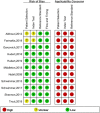Performance of Imaging Techniques in Non-invasive Diagnosis of Non-alcoholic Fatty Liver Disease in Children: A Systematic Review and Meta-Analysis
- PMID: 35899133
- PMCID: PMC9311375
- DOI: 10.3389/fped.2022.837116
Performance of Imaging Techniques in Non-invasive Diagnosis of Non-alcoholic Fatty Liver Disease in Children: A Systematic Review and Meta-Analysis
Abstract
Background and aim: Non-alcoholic fatty liver disease (NAFLD) has become the most common chronic liver disease in children. With the continuous emergence of various non-invasive diagnostic methods, imaging techniques have always been considered as potential alternative methods to liver biopsy. This study aimed to evaluate the diagnostic performance of imaging techniques so as to search for the most promising technology.
Methods: We searched English and Chinese databases. English databases included Cochran library, Embase, PubMed, and Web of Science, while Chinese databases included the Wanfang database and China National Knowledge Internet.
Results: Finally, 11 articles were included (12 studies, one of which included studies on both fibrosis and steatosis). Further, 26.2% of the participants had mild steatosis, 34.1% had moderate steatosis, and 34.9% had severe steatosis. Also, 64.0% had any fibrosis, 29.1% had significant fibrosis, 13.8% had advanced fibrosis, and 2.8% had cirrhosis. Irrespective of the grade of fibrosis, transient elastography (TE) had higher sensitivity (97-100%), whereas magnetic resonance elastography (MRE) had the lowest sensitivity (58-63%). The pooled sensitivity and specificity of imaging techniques in diagnosing steatosis were 89% (95% CI, 71-96) and 89% (95% CI, 72-96), and AUROC 0.95 (95% CI, 93-97), multifrequency magnetic resonance elastography-hepatic fat fraction (mMRE-HFF) had the highest sensitivity (87%, 95% CI 77-97), ultrasonography (US) had the lowest specificity (96%, 95% CI 92-98%).
Conclusion: Imaging techniques have a good diagnostic performance for children with NAFLD, especially the diagnosis of liver fibrosis based on ultrasound or magnetic resonance elastography. Compared with different imaging techniques, TE has the best performance in diagnosing significant fibrosis. Liver stiffness measurement (LSM) is expected to become a biological indicator for routine screening, dynamic monitoring of disease changes, and prognostic evaluation.
Keywords: children; elastography; imaging techniques; non-alcoholic fatty liver disease; non-invasive diagnosis.
Copyright © 2022 Yu, Liu, Hu, Gao and Huang.
Conflict of interest statement
The authors declare that the research was conducted in the absence of any commercial or financial relationships that could be construed as a potential conflict of interest.
Figures












Similar articles
-
Diagnostic accuracy of elastography and magnetic resonance imaging in patients with NAFLD: A systematic review and meta-analysis.J Hepatol. 2021 Oct;75(4):770-785. doi: 10.1016/j.jhep.2021.04.044. Epub 2021 May 13. J Hepatol. 2021. PMID: 33991635
-
Accuracy of controlled attenuation parameter (CAP) and liver stiffness measurement (LSM) for assessing steatosis and fibrosis in non-alcoholic fatty liver disease: A systematic review and meta-analysis.EClinicalMedicine. 2022 Jul 10;51:101547. doi: 10.1016/j.eclinm.2022.101547. eCollection 2022 Sep. EClinicalMedicine. 2022. PMID: 35844772 Free PMC article.
-
Magnetic Resonance Imaging-Proton Density Fat Fraction vs. Transient Elastography-Controlled Attenuation Parameter in Diagnosing Non-alcoholic Fatty Liver Disease in Children and Adolescents: A Meta-Analysis of Diagnostic Accuracy.Front Pediatr. 2022 Jan 11;9:784221. doi: 10.3389/fped.2021.784221. eCollection 2021. Front Pediatr. 2022. PMID: 35087774 Free PMC article.
-
Magnetic Resonance Imaging More Accurately Classifies Steatosis and Fibrosis in Patients With Nonalcoholic Fatty Liver Disease Than Transient Elastography.Gastroenterology. 2016 Mar;150(3):626-637.e7. doi: 10.1053/j.gastro.2015.11.048. Epub 2015 Dec 8. Gastroenterology. 2016. PMID: 26677985
-
Prospective comparison of transient elastography, MRI and serum scores for grading steatosis and detecting non-alcoholic steatohepatitis in bariatric surgery candidates.JHEP Rep. 2021 Sep 30;3(6):100381. doi: 10.1016/j.jhepr.2021.100381. eCollection 2021 Dec. JHEP Rep. 2021. PMID: 34786549 Free PMC article.
Cited by
-
Diet, exercise, and supplements: what is their role in the management of the metabolic dysfunction-associated steatotic liver disease in children?Endocrine. 2024 Sep;85(3):988-1006. doi: 10.1007/s12020-024-03783-7. Epub 2024 Mar 22. Endocrine. 2024. PMID: 38519764 Free PMC article. Review.
-
Management of metabolic-associated fatty liver disease: The diabetology perspective.World J Gastroenterol. 2023 Jan 7;29(1):126-143. doi: 10.3748/wjg.v29.i1.126. World J Gastroenterol. 2023. PMID: 36683717 Free PMC article. Review.
-
Noninvasive Diagnostic Technique for Nonalcoholic Fatty Liver Disease Based on Features of Tongue Images.Chin J Integr Med. 2024 Mar;30(3):203-212. doi: 10.1007/s11655-023-3616-1. Epub 2023 Dec 5. Chin J Integr Med. 2024. PMID: 38051474
References
-
- Dong Y, Jan C, Ma Y, Dong B, Zou Z, Yang Y, et al. Economic development and the nutritional status of Chinese school-aged children and adolescents from 1995 to 2014: an analysis of five successive national surveys. Lancet Diabetes Endocrinol. (2019) 7:288–99. 10.1016/s2213-8587(19)30075-0 - DOI - PubMed
-
- Abarca-Gómez L, Abdeen ZA, Hamid ZA, Abu-Rmeileh NM, Acosta-Cazares B, Acuin C. Worldwide trends in body-mass index, underweight, overweight, and obesity from 1975 to 2016: a pooled analysis of 2416 population-based measurement studies in 128⋅9 million children, adolescents, and adults. Lancet. (2017) 390:2627–42. 10.1016/s0140-6736(17)32129-3 - DOI - PMC - PubMed
Publication types
LinkOut - more resources
Full Text Sources

